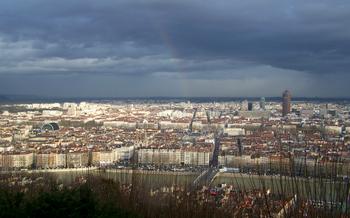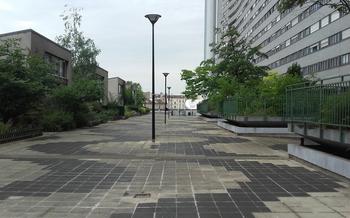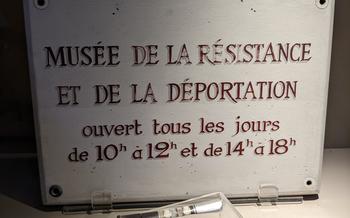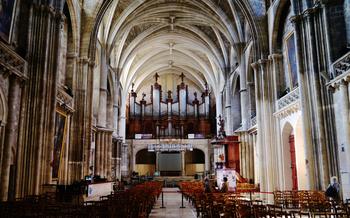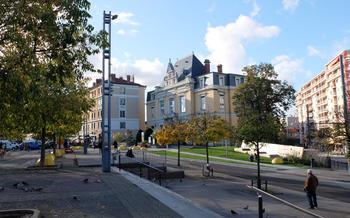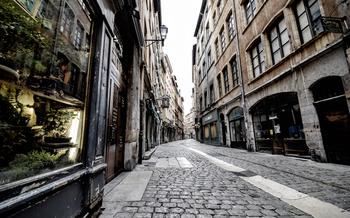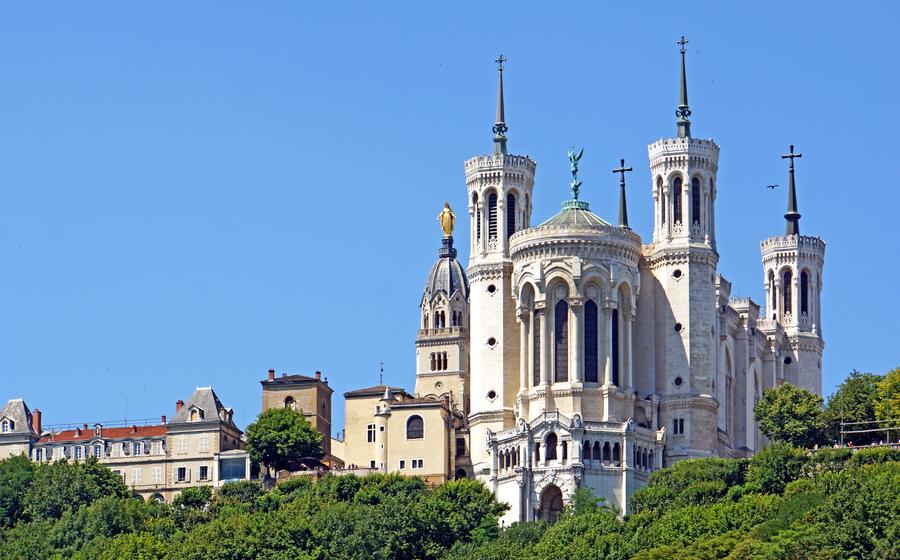
Notre Dame de Fourvière Basilica
- Historical Significance
- Location and Accessibility
- Architectural Highlights
- Interior Splendor
- Notre Dame de Fourvière Crypt
- Panoramic Views from the Esplanade
- Mass and Pilgrimage Center
- Nearby Attractions
- Practical Information
- Tips for Visitors
- Historical Anecdotes
- Cultural and Religious Significance
- Behind-the-Scenes Insights
- Local Festivals and Traditions
- Insider Tip: Free Guided Tours
Historical Significance
The Notre Dame de Fourvière Basilica stands as a testament to Lyon's rich history and religious heritage. Its foundations lie in the Roman influences that shaped the city, as evidenced by the discovery of ancient Roman artifacts during its construction. The basilica's religious significance is profound, serving as a prominent pilgrimage site and a symbol of Lyon's deep-rooted Catholic faith. It embodies the city's resilience and perseverance, having witnessed and survived numerous historical events, becoming an enduring symbol of Lyon's heritage.
The basilica's architectural style is a testament to the eclectic influences that have shaped Lyon's identity. Its Byzantine-Romanesque design, characterized by intricate mosaics, majestic domes, and detailed sculptures, showcases the blending of Eastern and Western architectural traditions. The basilica's grandeur and opulence reflect the city's prosperity and its status as a major religious and cultural center throughout history.
Location and Accessibility
Notre Dame de Fourvière Basilica stands atop Fourvière Hill, a prominent landmark overlooking the city of Lyon. Its hilltop position offers breathtaking panoramic views of the city, making it a popular destination for tourists and locals alike. The basilica is easily accessible by public transportation, with several bus lines stopping nearby. Alternatively, visitors can enjoy a scenic walk up the hill, taking in the charming streets and vibrant atmosphere of the surrounding neighborhood. For those arriving by car, there is limited parking available near the basilica.
Architectural Highlights
The Notre Dame de Fourvière Basilica stands as a testament to the architectural prowess of its time. Merging Byzantine and Romanesque styles, its design showcases intricate mosaics, a majestic dome, and detailed sculptures that captivate the eye. The facade boasts an opulent central doorway adorned with intricate carvings, while the interior is adorned with grand arches, vaulted ceilings, and stunning stained glass windows that flood the basilica with vibrant hues.
The basilica's most striking feature is its majestic dome, which soars above the city skyline. Inspired by the Hagia Sophia in Istanbul, the dome features a series of windows that allow natural light to pour in, illuminating the interior with a heavenly glow. The interior is further embellished with intricate mosaics that depict scenes from the Bible, creating a mystical and awe-inspiring atmosphere.
The basilica's intricate sculptures are another testament to the craftsmanship of its builders. Every nook and cranny of the basilica is adorned with statues, bas-reliefs, and carvings that depict saints, angels, and biblical figures, each one meticulously crafted to convey emotion and movement. The result is a visual feast that leaves visitors in awe of the artistic prowess of the basilica's creators.
Interior Splendor
Entering the Notre Dame de Fourvière Basilica is like stepping into a realm of celestial beauty. The interior of the basilica is a symphony of art and spirituality, where every element contributes to an awe-inspiring and sacred atmosphere.
The first thing that catches the eye is the stunning stained glass windows that adorn the basilica's walls. These magnificent windows, crafted by renowned artists, depict biblical scenes and stories with incredible detail and vibrancy. The play of light through the stained glass creates a kaleidoscope of colors that dances across the basilica's interior, transforming it into a luminous sanctuary.
Elaborate altarpieces, intricately carved and adorned with gold leaf, stand as testaments to the skill and artistry of the basilica's creators. These altarpieces, often featuring scenes from the life of Christ or the Virgin Mary, serve as focal points for prayer and devotion, inviting the faithful to contemplate the sacred mysteries of the Catholic faith.
The walls of the basilica are adorned with captivating wall paintings that narrate biblical stories and depict the lives of saints and martyrs. These vibrant frescoes, with their expressive figures and rich colors, bring the stories of the Bible to life, creating a sense of immediacy and connection with the past.
Marble and gold embellishments add a touch of opulence and grandeur to the basilica's interior. The gleaming marble floors, intricately carved columns, and shimmering gold accents create an atmosphere of reverence and awe. Every detail, from the delicate tracery of the stained glass windows to the intricate carvings on the altarpieces, contributes to the basilica's reputation as a masterpiece of sacred art.
Notre Dame de Fourvière Crypt
Beneath the grandeur of Notre Dame de Fourvière lies a hidden treasure – the crypt. Embark on a journey through time as you descend into this sacred space, steeped in history and spirituality.
The crypt dates back to the 12th century, serving as the foundation for the original Romanesque church that stood on this site. As the basilica evolved over the centuries, the crypt remained, a testament to its enduring significance.
Within the crypt, discover the Chapel of the Virgin, a sanctuary dedicated to the veneration of the patroness of Lyon. Here, you can glimpse the stunningly crafted statue of Our Lady of Fourvière, a symbol of hope and devotion for generations of pilgrims.
As you explore further, marvel at the archaeological remains that offer a glimpse into the basilica's past. Uncover fragments of ancient structures, inscriptions, and artifacts that tell the story of Lyon's rich heritage.
The crypt is a gateway to understanding the deep spiritual roots of Notre Dame de Fourvière. It invites you to reflect on the enduring faith that has shaped the basilica and the city of Lyon.
Panoramic Views from the Esplanade
The esplanade surrounding the Notre Dame de Fourvière Basilica is a viewing platform par excellence, offering unhindered vistas of Lyon and its surrounding landscapes. From this elevated vantage point, visitors are treated to a sweeping panorama that encompasses the city's iconic landmarks, including the Fourvière Tower, the Cathedral of Saint-Jean, and the confluence of the Rhône and Saône rivers.
The esplanade also provides a unique perspective on the basilica's majestic architecture. Standing at the foot of the grand structure, visitors can fully appreciate its sheer scale and intricate details. The esplanade is adorned with lush gardens, fountains, and sculptures, which add to its charm and serenity.
At dusk, the esplanade transforms into a magical spot to witness the city's transformation as the sun sets. The sky bursts into a myriad of colors, casting a warm glow over the cityscape. The twinkling lights of Lyon create a mesmerizing spectacle, making it an ideal location for capturing breathtaking photographs.
The esplanade of the Notre Dame de Fourvière Basilica is not just a viewing platform but a place to relax, reflect, and soak in the beauty of Lyon. Whether you're a history buff, an architecture enthusiast, or simply seeking a moment of tranquility, this spot offers an unforgettable experience.
Mass and Pilgrimage Center
As a significant religious site, the Notre Dame de Fourvière Basilica holds a special place in the hearts of Catholics worldwide. Its history as a pilgrimage center dates back to the 19th century, when pilgrims from all over France and beyond flocked to Lyon to pay homage to the Virgin Mary. The basilica's imposing presence on the Fourvière hill, overlooking the city, has made it a symbol of faith and devotion.
The basilica hosts regular masses and services throughout the week, attracting both local parishioners and visitors. During these services, the basilica's stunning interior comes alive with the sounds of the choir, the organ, and the prayers of the faithful. The atmosphere is one of reverence and spirituality, as people come together to celebrate their faith and connect with the divine.
One of the highlights of the basilica's religious calendar is the annual Festival of Lights, held every December. During this festival, the basilica and the surrounding area are illuminated with millions of colorful lights, creating a magical and enchanting atmosphere. The festival attracts visitors from all over the world, who come to witness the spectacle and celebrate the city's rich cultural and religious heritage.
Nearby Attractions
In addition to its own impressive beauty, Notre Dame de Fourvière is surrounded by a wealth of other captivating attractions that further enrich the visitor's experience.
Just a short walk away, the Basilica of Saint-Martin d'Ainay stands as a remarkable testament to the city's early Christian heritage. Founded in the 6th century, this ancient basilica exudes an aura of tranquility and spirituality, inviting visitors to step back in time and immerse themselves in the rich history of Lyon's Christian roots.
For those seeking a deeper dive into the city's past, the Vieux Lyon (Old Town) offers a treasure trove of historical wonders. This enchanting neighborhood, a UNESCO World Heritage Site, is a maze of cobblestone streets, secret passages, and hidden courtyards, each revealing a glimpse into Lyon's vibrant past. From the majestic Cathedral of Saint-Jean-Baptiste to the charming Place des Terreaux, Vieux Lyon is a living museum that transports visitors to another era.
To delve into the ancient Roman origins of Lyon, the Gallo-Roman Museum is an essential stop. This fascinating museum houses an impressive collection of artifacts from the city's Roman past, including mosaics, sculptures, and everyday objects. Visitors can trace the development of Lugdunum, the Roman capital of Gaul, and gain insights into the daily lives of its inhabitants.
Finally, the Fourvière Roman Theatre, located just steps away from the basilica, offers a glimpse into the city's vibrant cultural life during Roman times. This remarkably preserved theater, built in the 1st century AD, once hosted theatrical performances, gladiatorial contests, and other forms of entertainment. Today, it serves as a reminder of Lyon's rich cultural heritage and provides a unique venue for modern-day performances and events.
Practical Information
The Notre Dame de Fourvière Basilica is open to visitors daily from 8 am to 7 pm. Admission to the basilica is free, but donations are welcome. Guided tours are available in English and French for a fee.
For those with limited mobility, the basilica is wheelchair accessible, with ramps and elevators providing easy access to all areas.
Photography is permitted within the basilica, but flash photography is not allowed.
If you plan to attend a mass or service, please arrive early to secure a seat. Services are held in French, but English translations are available upon request.
For more information on visiting the Notre Dame de Fourvière Basilica, please visit the official website or contact the basilica directly.
Tips for Visitors
When visiting the Notre Dame de Fourvière Basilica, it is essential to show respect for the religious significance of the site. Visitors are expected to dress appropriately, avoiding shorts, tank tops, and revealing clothing. Noise and disruptions should be kept to a minimum to maintain the sacred atmosphere of the basilica.
To fully appreciate the basilica's grandeur, visitors are encouraged to attend a mass or service. This is an opportunity to witness the spiritual and cultural significance of the basilica firsthand and participate in the vibrant community of worshippers.
The panoramic views from the esplanade are not to be missed. Take your time to soak in the beauty of Lyon's cityscape, the meandering Saône River, and the verdant Fourvière Park. Capture the stunning vistas with your camera to cherish the memories of your visit.
Historical Anecdotes
The construction of the Notre Dame de Fourvière Basilica was not without its challenges. One of the most notable was the unstable foundation of the hilltop on which it was built. To overcome this, the architects had to design a unique system of underground vaults to support the basilica's immense weight. Another challenge was the sourcing of materials. Since the basilica was built during a period of economic hardship, the architects had to rely on donations and recycled materials. As a result, the basilica incorporates a variety of stones, including pink granite from nearby quarries and white limestone from Burgundy.
Over the centuries, the basilica has been the subject of numerous legends and mysteries. One of the most famous legends is that of the "golden statue." According to the legend, a golden statue of the Virgin Mary was hidden in the basilica during the French Revolution to protect it from being desecrated. To this day, some people believe that the statue is still hidden somewhere within the basilica, waiting to be discovered.
The basilica has also been visited by many famous people throughout history. In 1854, Pope Pius IX visited the basilica and blessed its foundation stone. In 1896, French President Félix Faure attended a mass at the basilica to celebrate the 50th anniversary of its inauguration. More recently, in 2016, Pope Francis visited the basilica and prayed before the statue of the Virgin Mary.
The Notre Dame de Fourvière Basilica has played a significant role in local history. During the Franco-Prussian War of 1870, the basilica served as a refuge for the people of Lyon who were fleeing the Prussian army. In 1944, the basilica was damaged by Allied bombs during World War II. However, it was quickly repaired and reopened to the public. Today, the basilica continues to be a symbol of Lyon's resilience and faith.
Cultural and Religious Significance
Notre Dame de Fourvière stands as a symbol of Lyon's unique identity, deeply entwined with the city's history and spiritual traditions. For centuries, it has been a place of pilgrimage, attracting devout Catholics from around the world who seek solace, guidance, and a connection with the divine. The basilica's significance extends beyond its religious function, as it has become an integral part of Lyon's cultural fabric.
Pilgrimage to Fourvière has a long and rich history, dating back to the Middle Ages when the site was believed to possess miraculous powers. In the 19th century, the basilica became a major destination for pilgrims from across Europe, particularly during the annual pilgrimage of the Fourvière. This event, which takes place every year on December 8th, draws thousands of faithful who gather to honor the Virgin Mary and pray for her intercession.
The basilica also plays a prominent role in local festivals and events. During the annual Fête des Lumières (Festival of Lights), the basilica's façade is illuminated with stunning light displays, creating a magical and enchanting atmosphere. The basilica is also the starting point for the Grand Pardon of Fourvière, a procession that takes place every year on the Sunday following Ascension Day. This procession, which dates back to the 16th century, is a symbol of thanksgiving and devotion to the Virgin Mary.
The cultural and religious significance of Notre Dame de Fourvière is further reflected in its representation in art and literature. The basilica has been depicted in numerous paintings and photographs, and it has served as a backdrop for countless stories and novels. Its unique architecture and spiritual aura have captured the imagination of artists and writers alike, making it a beloved and enduring symbol of Lyon's rich heritage.
Behind-the-Scenes Insights
Beyond the public eye, Notre Dame de Fourvière holds a vibrant religious community and a wealth of ongoing activities that contribute to its spiritual and historical significance. Daily mass and services bring together the faithful, fostering a sense of unity and devotion. The basilica also plays a crucial role in various festivals and events, including the renowned Fête des Lumières (Festival of Lights), where its façade becomes a canvas for spectacular light displays.
Behind closed doors, the basilica undergoes meticulous restoration and conservation efforts to preserve its architectural integrity and artistic treasures. Skilled artisans and conservators work tirelessly to maintain the basilica's grandeur, ensuring that future generations can continue to witness its beauty and historical significance.
Gaining a glimpse into the daily life of the basilica community offers a unique perspective on the spiritual and operational aspects of this sacred space. From the preparation of ceremonies to the upkeep of the basilica's grounds, the dedication and passion of the community members are evident in every detail.
Throughout the year, the basilica hosts special events and ceremonies that showcase its religious and cultural importance. These events range from solemn processions to joyous celebrations, attracting pilgrims and visitors alike to share in the basilica's rich heritage and spiritual traditions.
Delving into the behind-the-scenes aspects of Notre Dame de Fourvière provides a deeper appreciation for its enduring legacy and the tireless efforts made to maintain its status as a symbol of faith, beauty, and Lyon's rich cultural identity.
Local Festivals and Traditions
The Notre Dame de Fourvière Basilica is deeply ingrained in the cultural and religious fabric of Lyon, serving as a backdrop for various festivals and traditions that draw locals and visitors alike. The most prominent of these is the Fête des Lumières (Festival of Lights), a spectacular event that transforms the city into a radiant canvas of light installations, with the basilica serving as a centerpiece. During the festival, the basilica's facade and interiors are illuminated with vibrant projections, creating a mesmerizing display of lights and shadows.
Another significant event is the Pilgrimage of the Fourvière, held annually in May. This pilgrimage attracts thousands of faithful who gather to honor the Virgin Mary and seek her blessings. The procession winds its way through the streets of Lyon, culminating at the basilica, where a solemn mass is held.
The Grand Pardon of Fourvière, held in September, is another important religious celebration. This event commemorates the consecration of the basilica in 1896 and features a grand procession, masses, and other festivities.
Beyond these major events, the basilica is also a venue for local customs and rituals. Throughout the year, various religious services, concerts, and exhibitions are held, attracting a diverse audience. These events not only showcase the basilica's cultural significance but also provide opportunities for the community to come together and celebrate their shared heritage.
Insider Tip: Free Guided Tours
Delve deeper into the basilica's rich history and intricate details by joining one of the free guided tours offered by the basilica's knowledgeable staff. These tours provide an insider's perspective, allowing visitors to uncover hidden treasures and stories that might otherwise go unnoticed. Be sure to check the basilica's website or inquire at the information desk for tour schedules and availability.
